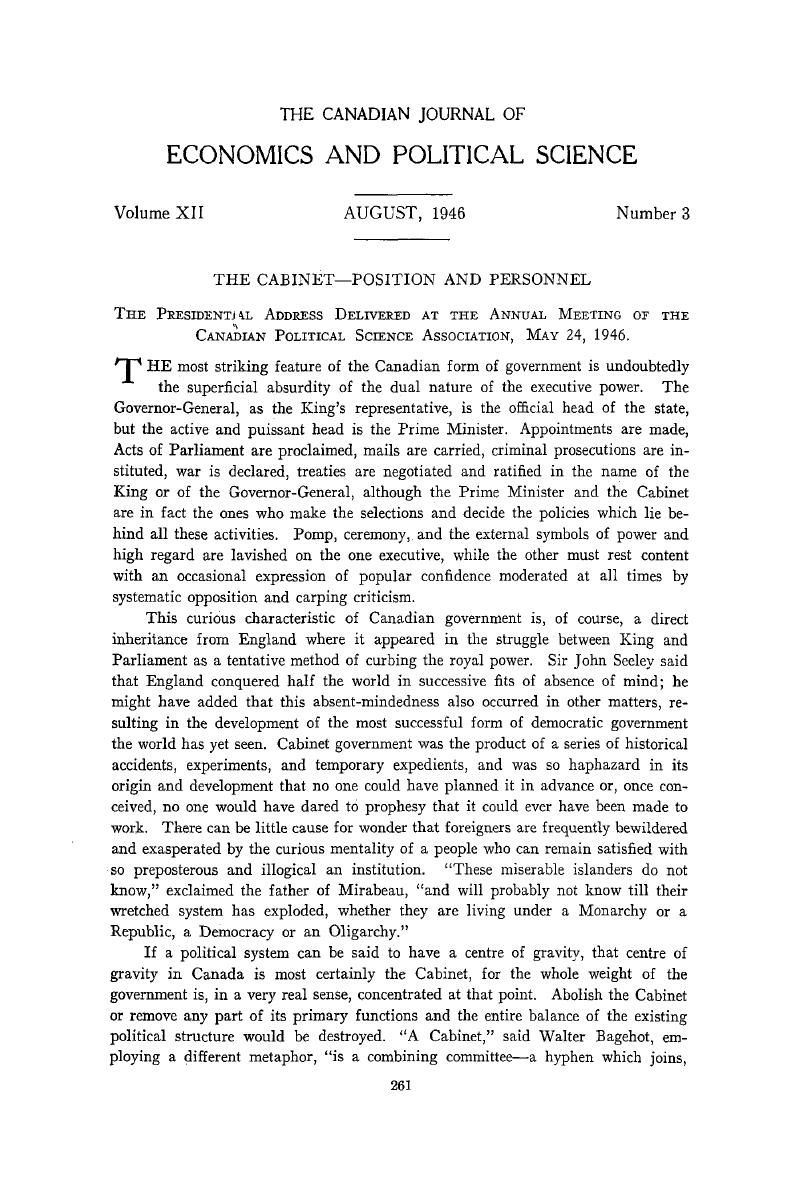Published online by Cambridge University Press: 07 November 2014

1 The parliamentary assistants (the quasi-ministers) could not, however, be paid under the terms of the parliamentary appropriation unless they were members of the House of Commons.
2 Parliamentary Guide, 1901; Coté, N. O., Political Appointments, Parliaments, and the Judicial Bench in the Dominion of Canada, 1896-1917 (Ottawa, 1917).Google Scholar
3 In recent years the Privy Council has had from sixty to ninety members.
4 A Cabinet Minister, and even the Prime Minister, may for a brief period not have a seat in either House; but one must be obtained within a reasonable time.
5 Studies in Literature (London, 1891), p. 338.Google Scholar
6 Quoted by Martin, Chester, Empire and Commonwealth (Oxford, 1929), p. 209.Google Scholar
7 This statement omits the partial coalition with which Confederation was begun. Coalition governments have not been uncommon in the provinces.
8 Section 11.
9 Canadian House of Commons Debates (unrevised), 11 12, 1945, p. 2041.Google Scholar
10 Ibid., March 18, 1903, pp. 132-3.
11 Ibid., May 15, 1909, p. 6723.
12 Rogers, N. McL., “Evolution and Reform of the Canadian Cabinet” (Canadian Bar Review, 04, 1933, pp. 232–4).Google Scholar
13 Bilkey, Paul, Persons, Papers and Things (Toronto, 1940), pp. 140–2.Google Scholar The above account is confirmed by one member of the Cabinet appointed at this time. Wallace, W. S., Memoirs of the Rt. Hon. Sir George Foster (Toronto, 1933), pp. 154–61.Google Scholar
14 “Mr. Christopher Dunhin: I think I may defy [the Government] to show that the Cabinet can be formed on any other principle than that of a representation of the several provinces in that Cabinet. It is admitted that the provinces are not really represented to any Federal intent in the Legislative Council [the proposed Senate]. The Cabinet here must discharge all that kind of function, which in the United States is performed, in the Federal sense, by the Senate. And.precisely as in the United States, wherever a Federal check is needed, the Senate has to do Federal duty as an integral part of the Executive Government. So here, when that check cannot be so got, we must seek such substitute for it as we may, in a Federal composition of the Executive Council; that is to say, by making it distinctly representative of the provinces” ( Confederation Debates, 1865, p. 497 Google Scholar).
15 In order to give provincial and sectional representation two of the leading figures in Confederation, D'Arcy McGee and Charles Tupper, were left out of the first Cabinet. Rogers, N. McL., “Federal Influences on the Canadian Cabinet” (Canadian Bar Review, 02, 1933, pp. 106–7).Google Scholar
16 Ibid., pp. 114-15.
17 Ibid., pp. 116-18.
18 See Dawson, R. MacG., Constitutional Issues in Canada, 1900-31 (Oxford, 1933), pp. 111–16.Google Scholar
19 Buckingham, W. and Ross, G. W., The Hon. Alexander Mackenzie, his Life and Times (Toronto, 1892), p. 354.Google Scholar
20 Grain Growers' Guide, October 5, 1921.
21 Canadian House of Commons Debates, 05 15, 1909, p. 6725.Google Scholar
22 London Spectator, April 29, 1916.
23 Canadian House of Commons Debates, 04 15, 1904, p. 1306.Google Scholar Mr. Borden's reply was that he did not receive it “wrongfully,” that it “was placed in my hands without any restrictions whatever as to the use which should be made of it” by one who had no connexion with the Government.
24 Ibid., November 29, 1944, p. 6659. See ibid., November 22, 1944, pp. 6505-10.
25 The outstanding Cabinet rebellion in Canadian history was that of seven members of the Bowell Ministry in 1896 with the result that the Prime Minister was compelled to agree to the terms dictated by the rebels.
26 See ibid., January 8, 1926, pp. 15-16; H. R. Greaves, G., The British Constitution (London, 1941), pp. 108–17.Google Scholar
27 The British and Australian practice suggests that this portfolio could be given to another Minister without any disastrous consequences. The link between the two in Great Britain, however, has always been very close, and the British Prime Minister is supposed to see all the more important despatches of the Foreign Office.
28 See, for example, P.C. 1639, July 19, 1920, in Dawson, R. MacG., Constitutional Issues in Canada, 1900-1931, pp. 125–6.Google Scholar
29 Mr.King, Mackenzie described Mr.Lapointe, as “the closest, the truest and the most devoted friend I have had in my political life” (Canadian House of Commons Debates, 11 27, 1944, p. 6616).Google Scholar
30 Jones, Thomas, “Prime Ministers and Cabinets” (The Listener, 10 13, 1938, pp. 788–9).Google Scholar
31 Skelton, O. D., Life and Letters of Sir Wilfrid Laurier (2 vols., Toronto, 1921), vol. II, pp. 176–83.Google Scholar
32 Canadian House of Commons Debates, 05 23, 1923, pp. 3047–8.Google Scholar
33 SirLow, Sidney, The Governance of England (London, 1918), p. 158.Google Scholar